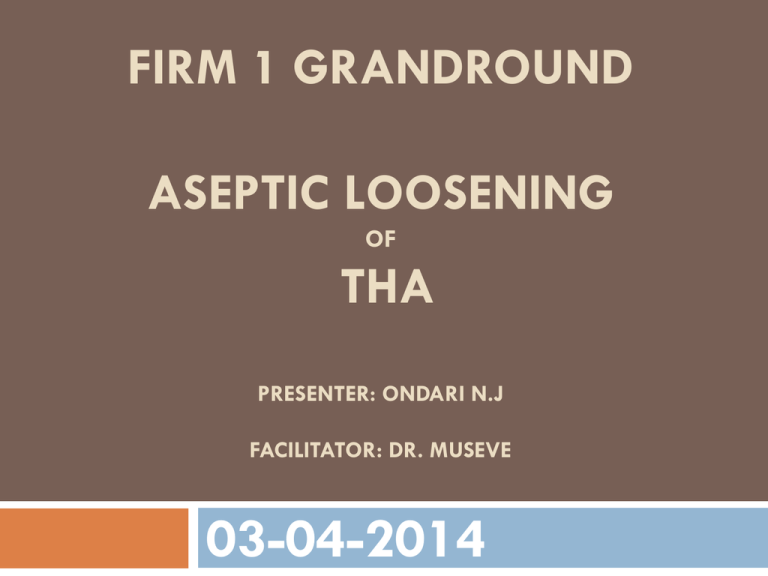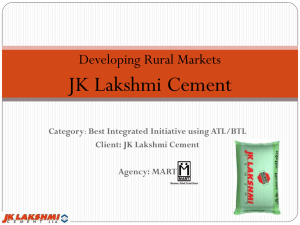ASEPTIC LOOSENING THA
advertisement

FIRM 1 GRANDROUND ASEPTIC LOOSENING OF THA PRESENTER: ONDARI N.J FACILITATOR: DR. MUSEVE 03-04-2014 Incidence of hip arthritis is 3-5% in >55yrs A good prosthesis important Biomechanics THA components bears atleast 3X body weight Abductor lever arm ~2.5X body lever arm Abductor lever arm may be dec by OA or neck shortening Lever arm ratios can increase to 4:1 Lenghts of lever can be surgically changed to approach 1:1 This theoretically reduces load hip by 30% Medialization of acetabulum Lateral and distal reattachment of osteotomized GT Stress transfer to bone Bone quality determines most appropriate implant Dorr radiographic classification of proximal femur Type A femurs Type B femurs Thick cortices Narrow distal canal – ‘champaigne flute’ appearance Found in young pts Permits good fixation Exhibit bone loss, shape not compromised Implant fixation not a problem Type C femurs Thin cortex, wide medullary canal – ‘stovepipe’ shape Occurs in older osteoporotic women Less favorable for implant fixation Dorr classification of morphology of femur Stress transfer to bone Stress transfer to bone desirable Measures to decrease stress shielding Decrease modulus of elasticity of stem eg titanium alloy Smaller diameter stems Prosthetic collar Stem shape Tapered geometries better Complications of THA Intraoperative Mortality, nerve injuries, vascular injuries Early postoperative Thromboembolism, hemartoma formation, infection, dislocation, limb length discrepancy Late postoperative Heterotopic ossification Loosening Most serious long term problem Loosening of THA components Most serious complication Commonly leads to revision With Cemented THAs, the acetabulum is the first component to fail from loosening With cementless hips, the femoral component loosens more often as a result of osteolysis Can be septic or aseptic Zones of loosening Femoral component Seven Gruen zones Acetabular component Three Delee and Charnley zones Gruen 7 zones of femur Delee and Charnley acetabular zones Cemented Femoral loosening; Radiographic features Definite loosening Stem failure – fracture/deformation Cement mantle fracture esp zone 4 Radiolucency >1mm Changes in stem position- usually varus position Pistoning effect Probable loosening Continous radioluscent line at bone-cement interface Endosteal cavitation-linear and focal osteolysis Possible loosening Radioluscent lines at bone-cement interface 50-100% Are all radioluscent line due to loosening? Radioluscent lines btn femoral cortex and cement can be produced by; Cancellous bone not completely removed during sx Normal age related expansion of femoral canal assoc cortical thinning. Poss et al study; Medullay canal expands at 0.33mm/yr Cortical thickness decrease by 0.14mm/yr NB; these radioluscet lines do not typically have the surrounding sclerotic line noted on loose femoral stems Medullary canal widening has not been implicated in the process of femoral loosening Technical problems that contribute to stem loosening Failure to remove adequate cancellous bone medially Inadequate quantity of cement Thin column cracks easily Tip of stem should be supported by a plug of cement Cements laminations Presence of voids in cement Poor mixing, injecting technique, blood or fragments of bone Failure to pressurize cement Failure to prevent stem motion while cement is hardening Failure to position component in neutral or mildly valgus position Cementless femoral components Cemented Acetabular loosening; radiographic features Bone-cement lucency >2mm and/or progressive Medial migration and protrusion of cement and cup Change in inclination of cup >50 Eccentric PE wear of the cup Fracture of cup and/or cement(rare) Technical problems during sx leading to cup loosening Inadequate support of the cup by bone & cement Insufficient bone stock Acetabullum not reamed deeply enough Failure to remove all cartilage, loose bone fragments, fibous tissue and blood Failure to make sufficient no of holes in acetabulum to secure good cement-bone bon Failure to pressurize cement Failure to distribute cement around entire outer surface of cup Mvt of cup or cement mantle while cement is hardening Malpositioning of cup – neck of femoral component impinges on margin of socket Pathophysiology Generation of particulate debris Wear corrosion Mechanisms of wear Adhesion, Wear debris sources PE, abrasion, microfatigue and 3rd body wear cement, metal particles PE bearing surfaces are the major factor responsible for periprosthetic osteolysis Pathophysiology cont. Particle size important 0.5 – 10microm – pagocytosed <0.5microm – too small to activate a response >10microm – stimulate a giant cell response Irregularly shaped particles more active than spherical poarticles Modes of wear Is the mechanical condition under which prosthesis was working when wear occurred Four modes Mode 1 Motion Mode 10 btn two bearing surfaces as intended by designer 2 bearing surface rubbing against 20 surface Mode Two Mode Two 3 10 surfaces with interposed third-body particles 4 non-primary surfaces rubbing together OSTEOLYSIS Is the final pathway related to host cellular response to debris of all types Mechanism Generation of wear particles Access of these particles to periprosthetic bone Cellular response to particulate debris Debris dispensed through joint fluid by pressure gradient Pattern of lysis depends on implant design Osteolysis; cellular response MQs predominant cells Surface interaction btn MQs and wear debris incite inflammatory response whether or not phagocytosis occurs Multiple cytokines/chemokines produced Osteoclasts activated, osteoblasts inhibited Net result – bone resorption osteoclast osteoblast interaction DEBRIS MACROPHAGES phagocytosis cytokines/ chemokines inhibit Diagnosis History Pain on wt bearing –groin, buttock or thigh Typically ‘start-up’ pain Pain relieved by rest, aggravated by hip rotation Physical exam Antalgic gait Limb length discrepancy Investigations Laboratory R/O infection Imaging Progressive radiolucency Migration of implant Treatment Asymptomatic patient Radiographic loosening often appears be4 symptoms More frequent follow-up Revision surgery if bone destruction is progressive Symptomatic patient Revision surgery Indications for surgery Symptomatic patient Loose implants Large lytic lesions Progressive osteolysis even if no symptoms Revision Total Hip Arthroplasty cementless components are generally preferred in revision settings. The bone sclerotic and does not provide optimal conditions for cement interdigitation only the loose components need to be revised If implant remains stable despite osteolysis, bone grafting of the defects with retention of the implant is recommended








